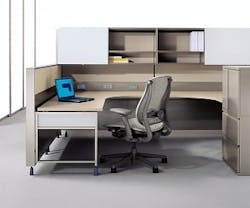Can an Ergonomic Office Enhance Productivity?
Healthy and comfortable workers can lead to healthy, productive buildings. From the moment workers sit down in the morning until they leave at the end of the day, it’s important to have them in a work station that best equips them for success.
A recent survey from Staples Advantage shows that one in two U.S. workers say they’d be more productive in a more comfortable and ergonomic workspace. Plus, with 86% of employees experiencing some discomfort from their office furniture and equipment, there’s room to make strides in providing a more ergonomic office environment.
Ergonomic enhancements don’t have to mean refurbishing offices with top-of-the-line, executive-level chairs or overhauling the technology set-up. In fact, high-impact ergonomic tweaks often come at a low (or no) cost. Building owners and facility managers can work with companies to promote employee education – spreading awareness of ergonomic best practices and providing tips for optimal equipment use.
Here are five no-cost tips from Staples Advantage – with ergonomic advice that can be provided to employees to help make your building a more comfortable and productive one:
Sit pretty. Correct posture can help reduce shoulder, neck and back tension. The best seated position is a reclined posture of 100 to 110 degrees, with your neck and shoulders relaxed. Lower arms should be at right angles – or slightly more open – preferably resting on the chair’s armrests so that your wrists are straight when using the keyboard.
Chairs should also be adjusted correctly – for example, with the seat height at a level that enables your feet to be firmly planted on the floor, with your upper legs angled slightly downward. Your thighs should have sufficient clearance space to fit under the desk or keyboard tray.
Mind the monitor. Making tweaks to your monitor settings can help reduce eye strain and neck pain. For example, take time to adjust the brightness and contrast of your screen. Oftentimes, black characters against a light gray background are easiest on the eyes. You can also adjust screen resolution and use the zoom feature in programs to make sure characters are a comfortable and readable size.
Monitor placement is also key. Monitors should be at eye height, an arm’s distance away (18 to 30 inches from your eyes) and positioned so that your eyes look forward and slightly downward. Also, make sure your monitor screen isn’t facing a bright window, which can make it difficult to read.
Consider keyboard placement. Regardless of whether you’re using an ergonomic or standard keyboard, it should be placed directly in front of you, so that your wrists and hands align with your forearms. Forearms should be horizontal – at right angles to your upper arm – and elbows should be kept in.
Use the mouse effectively. Keep the mouse at the same level as your keyboard, so you’re not contorting and twisting your hands and arms. In addition, don’t hold the mouse too tightly; holding it with a light grasp will alleviate hand and finger tension. During periods of heavy mouse use, keep the mouse in front of you; otherwise, if alternating between mouse use and typing, keep the mouse to the side of the keyboard. You can also customize mouse software – adjusting the speed, pointer size and response – to meet your needs.
Take breaks. It’s important to periodically change positions and take breaks from keyboard use and from staring at the screen. Try to do something active every 30 minutes – whether it’s filing papers, grabbing a glass of water, or taking/making a phone call.
